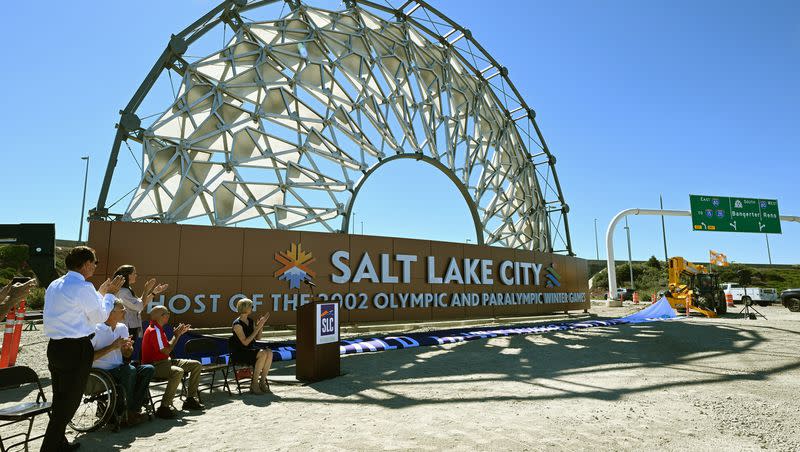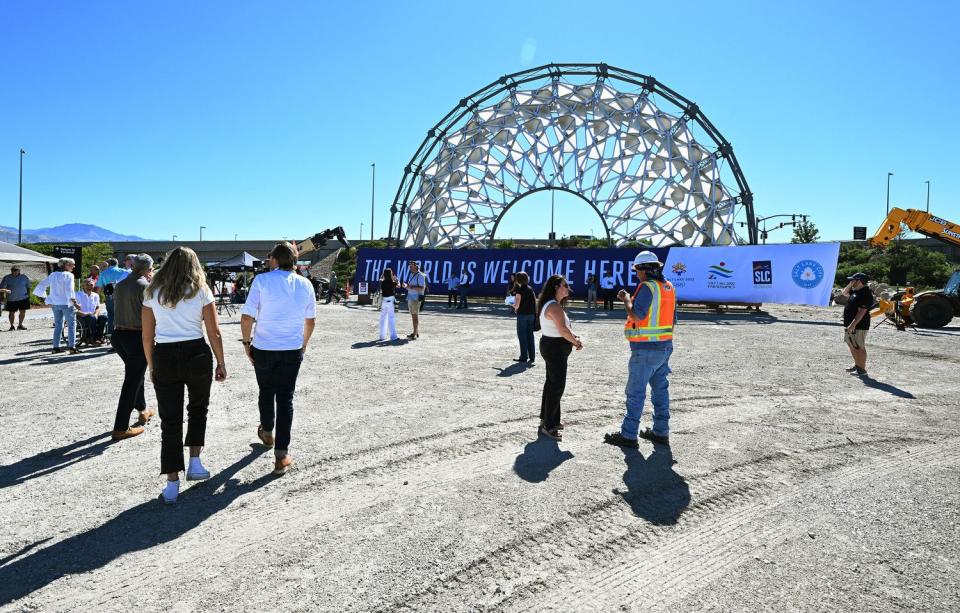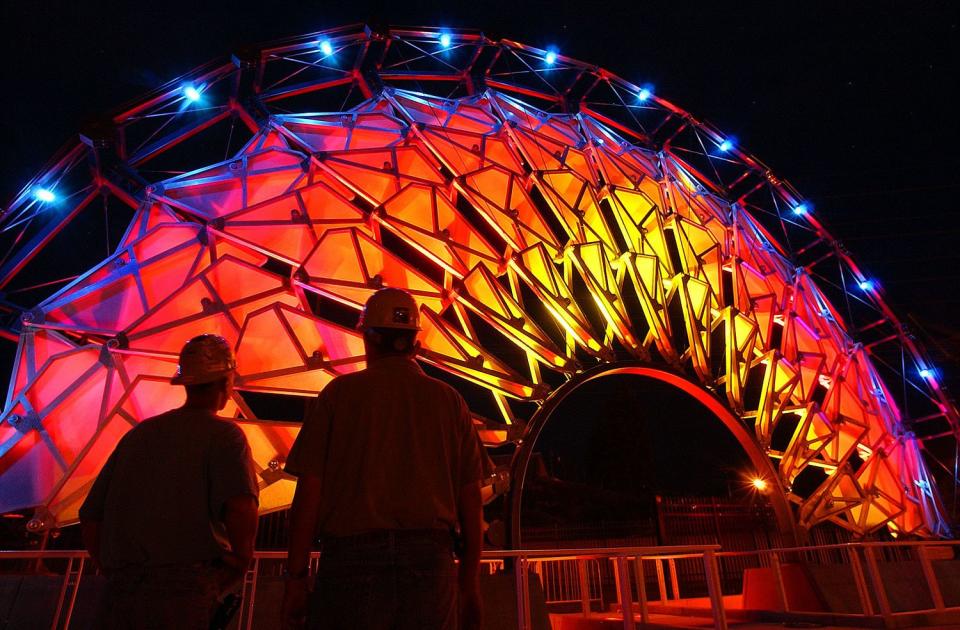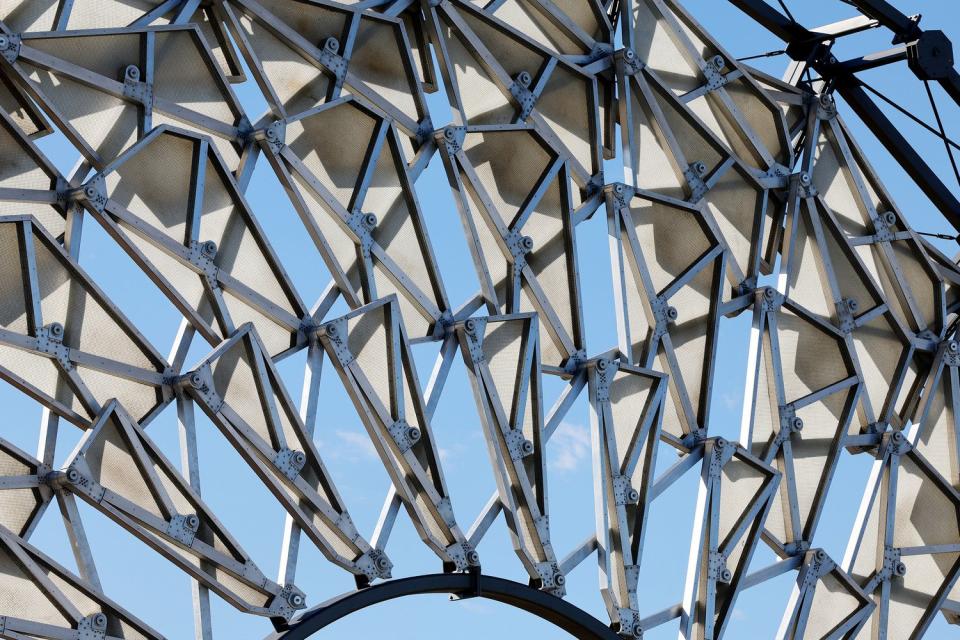Iconic symbol of Salt Lake City's 2002 Winter Olympics finds its 'perfect home'

- Oops!Something went wrong.Please try again later.
A flood of memories rushed back to Derek Parra Tuesday as crews unfurled a banner revealing the new home for the Hoberman Arch outside of Salt Lake City International Airport to the tune of "Call of the Champions," the official theme song of the 2002 Salt Lake City Winter Olympics.
It brought Parra back to the Games' 1,500-meter speedskating finals, an event he won for his first and only career Olympic gold medal. After going through the emotions of winning, rounds and rounds of interviews and drug testing, the whirlwind day took him to the downtown OIympic Medal Plaza and the arch.
There, on that stage, he felt the weight of his long journey to the Salt Lake Olympics and all the people who helped him get to his long-standing dream.
"This piece of art is pretty impactful for me because it is so symbolic not only of my journey to the Games, but also just my life today," he said, standing in the shadow of the massive 31,000-pound structure. "And I think this arch is so symbolic of that, of what it takes to be successful in anything we do in life."
Parra now hopes that Hoberman Arch will inspire even more people as it returns to the public spotlight.
Salt Lake City leaders, former Olympians and members of the Salt Lake City-Utah Committee for the Games gathered Tuesday to celebrate the reinstallment of the art piece during a ceremony Tuesday. It marks the first time that the piece has been on public display in nearly a decade.
"I believe the Hoberman Arch has found its perfect home," said Fraser Bullock, president and CEO of the committee. "It will get millions of views (from) people from our own community passing by (and) guests from around the world to see this great city. It is a symbol to help us remember that the people of Utah hosted one of the greatest Games in history."

Chuck Hoberman, an artist and architect, designed the massive arch for the 2002 Games, using more than 4,000 individual pieces. His goal was to create a one-of-a-kind piece that highlighted the "beauty and athleticism" of all the Olympians competing in the global event, he explained in a statement that Salt Lake City Mayor Erin Mendenhall read during a small ceremony Tuesday.
The structure resembled the movement of a human iris, but also honored Utah, as a nod to the state's many natural stone arches. Creating it was "one of the true high points of my life," Hoberman added.
It was, at the time, the largest unfolding structure in the world, and athletes like Parra were able to view it up close during medal ceremonies.

Hoberman Arch ultimately ended up at Rice-Eccles Stadium after the Games ended, joining several other relics of the 2002 Olympics. It remained there until it was taken apart and moved out of the public eye in 2014 following "long-term negotiations" with the city at the time.
Gordon Huether, an artist who has worked on several art installations at Salt Lake City International Airport, said the iconic art piece was "chopped up a little bit" when it was disassembled, while some pieces were also stolen before it was moved to a "secret location."
Airport officials hired Huether to rebuild the arch, a task he says turned out to be "quite a feat." The job required reassembling all the unmarked pieces scattered all over the place and finding replacement pieces for all the parts lost over the past decade.

In all, it cost $3.79 million to rebuild and relocate Hoberman Arch to its new home. Its 4,000 individual pieces are connected by 96 panels and 13,000 steel rivets, airport officials say.
Hoberman Arch also stands on a new 72-foot-wide base honoring those 2002 Winter Games. However, Mendenhall said the city intentionally left additional space to add a note about either the 2030 or 2034 Winter Games, which the city is vying for.
The International Olympic Committee is expected to pick a 2030 host city next year.
While city and state officials wait, Hoberman Arch is ready to welcome people from all over the world "again and again" as it did originally 21 years ago, regardless if Salt Lake City is a future Olympic host, the mayor added.
"It deserves to be displayed," she said. "It's a part of our legacy, a part of our identity and it's a part of our passion for being an Olympic city."

